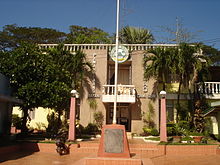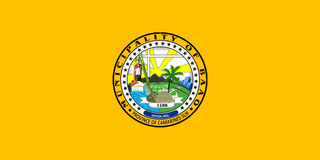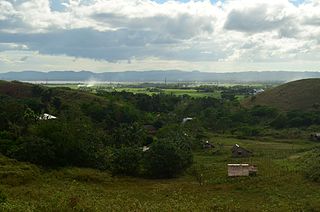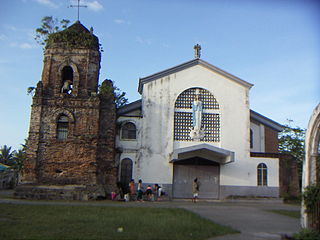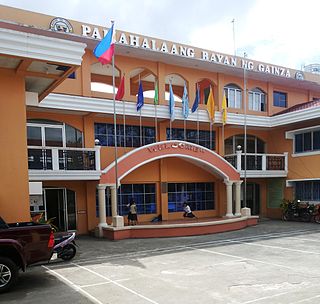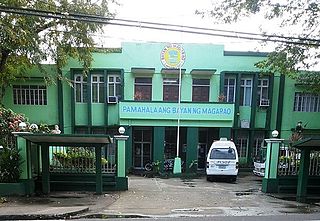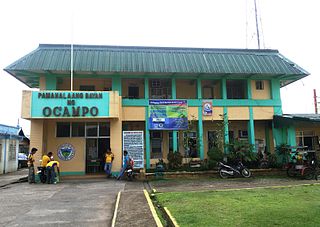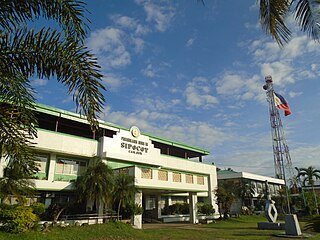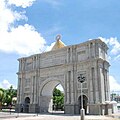This article needs additional citations for verification .(January 2013) |
Pasacao | |
|---|---|
| Municipality of Pasacao | |
 Aerial shot of Pasacao with its port and oil depot | |
| Nickname: Summer Capital of Camarines Sur | |
| Motto: Matatag [lower-alpha 1] na Bayan ng Pasacao | |
 Map of Camarines Sur with Pasacao highlighted | |
Location within the Philippines | |
| Coordinates: 13°30′37″N123°02′31″E / 13.5103°N 123.0419°E | |
| Country | Philippines |
| Region | Bicol Region |
| Province | Camarines Sur |
| District | 2nd district |
| Founded | 1872 |
| Barangays | 19 (see Barangays) |
| Government | |
| • Type | Sangguniang Bayan |
| • Mayor | Jorge R. Bengua |
| • Vice Mayor | Maryol O. Tayco |
| • Representative | Luis Raymund F. Villafuerte Jr. |
| • Municipal Council | Members |
| • Electorate | 31,618 voters (2022) |
| Area | |
| • Total | 149.54 km2 (57.74 sq mi) |
| Elevation | 36 m (118 ft) |
| Highest elevation | 756 m (2,480 ft) |
| Lowest elevation | 0 m (0 ft) |
| Population (2020 census) [3] | |
| • Total | 53,461 |
| • Density | 360/km2 (930/sq mi) |
| • Households | 11,971 |
| Demonym | Pasaqueño (Masculine) Pasaqueña (Feminine) |
| Economy | |
| • Income class | 3rd income class municipality |
| • Poverty incidence | 41.62% (2015) [4] |
| • Revenue | ₱197,378,822.82 |
| • Assets | ₱ 528.4 million (2020) |
| • Expenditure | ₱ 137.2 million (2020) |
| • Liabilities | ₱ 168.3 million (2020) |
| Service provider | |
| • Electricity | Camarines Sur 1 Electric Cooperative (CASURECO 1) |
| • Water | Pasacao Water District (PAWADI) |
| Time zone | UTC+8 (PST) |
| ZIP code | 4417 |
| PSGC | |
| IDD : area code | +63 (0)54 |
| Native languages | Central Bikol Tagalog |
| Major religions | Roman Catholicism |
| Feast date | August 30 |
| Catholic diocese | Diocese of Libmanan |
| Patron saint | Saint Rose of Lima |
| Website | pasacao.gov.ph |
Pasacao, officially the Municipality of Pasacao (Central Bikol : Banwaan kan Pasacao; Tagalog : Bayan ng Pasacao), is a 2nd class municipality in the province of Camarines Sur, Philippines. According to the 2020 census, it has a population of 53,461 people. [3]
Contents
- Etymology
- History
- Spanish colonization
- Japanese occupation
- Geography
- Barangays
- Climate
- Demographics
- Language
- Religion
- Economy
- Culture
- Town Fiesta and Pasa-Pasa Ikaw Festival
- Daruanak Summer Festival
- Attractions
- Infrastructure
- Ports
- Pasacao-Balatan Tourism Coastal Highway
- Education
- Notes
- References
- External links
It is famed for its stretch of brownish sand beaches, earning it the title "Summer Capital of Camarines Sur". [5] The municipality's landmarks include the town's symbol, Daruanak Island, and the Port of Pasacao.
During the Spanish colonization in the 16th century, Pasacao was one of the embarkation points in Camarines Sur and was the only sea transportation link to Manila. It played a vital role in the development of commerce and trade in the province. [6]
The town was formed in 1872, according to records from the Archdiocese of Cáceres. [6]





